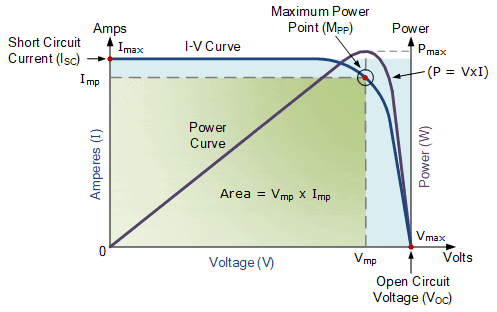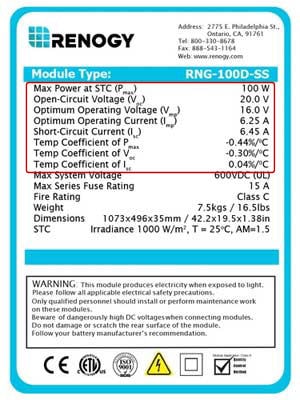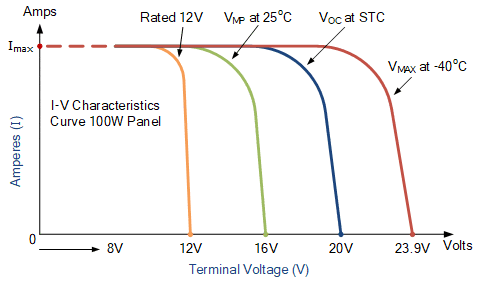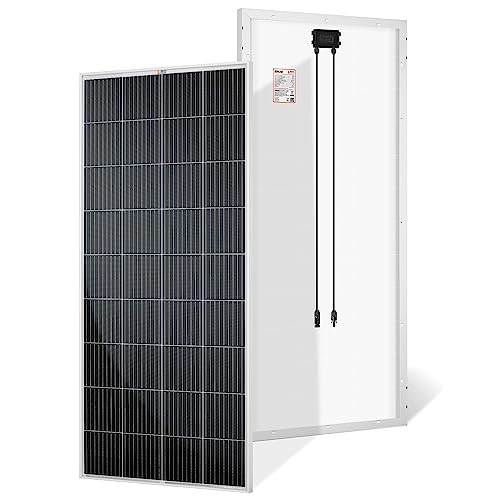
Temperature Coefficient
Temperature Coefficient of a PV Cell
![]() Here at Alternative Energy Tutorials we get asked many times about connecting photovoltaic solar panels together in series or parallel for more power. But the maximum panel or array voltage “seen” by a charge controller is not only the manufacturers rated voltage of the panel, 12V, 24V, etc, but is a combination of its open-circuit voltage, VOC and its temperature coefficient.
Here at Alternative Energy Tutorials we get asked many times about connecting photovoltaic solar panels together in series or parallel for more power. But the maximum panel or array voltage “seen” by a charge controller is not only the manufacturers rated voltage of the panel, 12V, 24V, etc, but is a combination of its open-circuit voltage, VOC and its temperature coefficient.
There are a number of factors which can affect the actual performance of a photovoltaic panel causing it to vary away from its theoretical value, and one of those is Temperature Coefficient, or more specifically Open-Circuit Voltage Temperature Coefficient given in either a percentage of VOC per degree C, ( %/oC ) or volts per degree C, (V/oC).
Clearly there are also other factors that affect a photovoltaic module (or array) performance such as: photovoltaic types (monocrystalline, polycrystalline), amount of solar irradiance (in m2), connected load impedance (Z) for maximum power transfer, as well as the age of the pv panel, since panel performance degrades overtime with age, etc.

The temperature coefficient of a solar cell is the amount by which its output voltage, current, or power changes due to a physical change in the ambient temperature conditions surrounding it, and before the array has begun to warm up.
Specifically, the ratio of the change of electrical performance when the temperature of the pv panel (or array) is decreased (or increased) by multiples of 1oC, relative to its quoted 25oC STC reference temperature.
For example, a Temperature Coefficient of 0.25% per oC means that for every 1oC change in temperature, the voltage, current or power output of the panel will change by one-quarter of one percent.
Thus for every 1oC temperature change above 25oC (hotter), the pv panel temporarily loses 0.25% of its voltage. But equally, for every 1oC below 25oC (colder), the pv panel’s voltage increases by 0.25%. That is in hot weather, a lower VOC and therefore lower VMP, and in cold weather, a higher VOC and higher VMP.
Estimating the temperature variation in which a pv panel, module or array operates, helps to determine the temperature-adjusted voltages from the panel. The exact temperature values would be based on your location.
Photovoltaics and panels are devices that produces DC electricity in direct proportion to the amount of solar radiation that falls onto their surface. Therefore, the power output of a pv panel can be calculated over a range of different light conditions.
We know from previous tutorials that a pv panel is made up of many individual photovoltaic cells wired together to produce a rated power output, given in watts, at full sun (1000W/m2). We also know that multiple pv panels can be connected together to form a pv array which can produce more solar output power than just one single solar panel.
A photovoltaic solar cell produces current over a range of voltages from 0V (short-circuit) to its maximum open-circuit voltage at VOC. Since a pv cell does not produce any voltage output when short circuited, as ISC x 0 volts = 0 watts. It also does not produce any output current when open circuited, as 0 amps x VOC = 0 watts, the maximum output power from a pv cell (or panel) must occur at some combination of output current and voltage at full sun.
Consider a typical solar cell I-V characteristics curve as shown below.
Solar Cell I-V Characteristic Curve

The above graph shows the current-voltage (I-V) characteristics curves of a typical silicon PV cell operating under normal solar conditions. With the pv cell open-circuited, that is not connected to any load, the cell current (I) will be at its minimum (zero) value, but the voltage across the cell will be at its maximum, VOC.
At the other extreme, when the solar cell is short circuited, that is the positive and negative leads connected together, the voltage (V) across the cell will be at its minimum (zero) but the current flowing through the cell will be at its maximum, ISC
But the parameter of interest for us here is that given for the cells open-circuit voltage, VOC as this is the maximum voltage generated by a pv cell, panel, module, or array, when exposed to sunlight with no-load, or a very light controller, battery or inverter load connected. As a pv cell’s voltage is directly affected by its operating temperature.
Open-Circuit Voltage Temperature Coefficient
The electrical operating characteristics of a particular photovoltaic panel or module, given by the manufacturer, is when the panel is operating at an ambient temperature of 25oC. But the open-circuit voltage of a pv panel will increase as the panels temperature decreases. The result is that an overvoltage conditions could occur when multiple panels are connected together in a series string potentially damaging any connected charge controllers or inverters.
Since temperature has a significant effect on a photovoltaic panel’s output, manufacturers specify a “temperature coefficient” parameter for each panel which shows the percentage of voltage change, (or millivolts of voltage change) per 1oC of panel temperature change above or below the standard rating of 25oC.
While charge controllers are vital components in any off-grid or battery-based pv system, as they prevent pv panel’s module’s or array’s from overcharging the batteries while at the same time optimizing charge current, but there is a limit to the maximum input voltage which can be applied.
Consider the Renogy 100 Watt, 12 Volt Monocrystalline Solar Panel label below.
Solar Cell I-V Characteristic Curve

At a standard STC (Standard Test Conditions) of a pv cell temperature (T) of 25oC, an irradiance of 1000 W/m2 and with an Air Mass of 1.5 (AM = 1.5), the solar panel will produce a maximum but continuous output power (PMAX) of 100 Watts.
This 100 watts of output power produced by the pv panel is the product of its maximum power point voltage and current, that is: P = V x I. The Renogy label tells us that VMP = 16.0 volts and IMP = 6.25 amperes.
Thus, 16.0 x 6.25 = 100 watts.
The Renogy label also tells us that the open-circuit voltage, VOC will be 20.0 volts when the panels terminals are in an open circuit no-load condition, some 4.0 volts higher than its VMP value.
But more interestingly it also tells us that the temperature coefficient of the pv panel is: -0.30% per oC of VOC.
While the panels electrical specifications label does not state the operating temperature range, most standard panels from a good manufacturer are easily capable of operating at temperatures of between -40oC and +85oC (-40 to 185oF).
Clearly -40oC is arctic conditions, but let’s assume that the coldest temperature for a given site drops down to this -40oC (-40oF), if only for a few clear sunny days. What would the maximum output voltage of the panel be at this lower temperature. (You can find your location’s maximum low and high temperatures online.)
- VOC of the Renogy PV panel above at STC (25oC) is given as: 20V
- Temperature difference between STC and lowest temperature value = 25oC – (-40oC) = 65oC
- The pv panel’s temperature coefficient specification is given as: 0.30% per oC of VOC
- If VOC = 20V, then (20/100) x 0.3% = 0.06 volts change per 1 degree of temperature change
- The increase in VOC at this -40oC temperature equals: 65oC x 0.06 = 3.9 volts
- Thus, the panels VOC voltage value at our -40oC temperature will be 20V + 3.9V = 23.9V
- That is: 20 x [1 + ((-65/100) x -0.3)] = 23.9 volts
So while this Renogy 100 Watt Solar Panel is referenced and sold as a 12V panel, its VMP value is 16.0 volts, its VOC value at STC is 20.0 volts, but its extreme low weather value is 23.9 volts, some 3.9 volts higher than its rated VOC value, and double that of its standardised 12 volt value as shown.
PV Panels Voltage Curves

So we can see that a pv panels open-circuit voltage will increase as the ambient temperature decreases, based on the standard 25oC STC reference temperature.
The opposite is also true that VOC will decrease as the ambient temperature increases. For example at the maximum working temperature of +85oC, VOC = 16.4 volts. A 7.5V voltage span (23.9 – 16.4) over the pv panels working temperature range.
Then while the panels current output will vary slightly with changes in ambient temperature, it is the voltage extremes that are of interest to us as it is this that determines the number of pv panels per series string depending on the model of charge controller (or inverter) used.
For example, let’s assume we have a charge controller that has a maximum array voltage input of 110 VDC. Initially you may think that you could use 9 series 12V panels as 12 x 9 = 108 volts. Or looking at the panels VOC value given as 20 volts, you could use 5 series panels per string as 20 x 5 = 100 volts. But this may not be the case, so let’s take a closer look.
The maximum number of our Renogy PV panels above that we can use in one series string, based on the charge controller’s 110 V maximum voltage input would be:
Three series panels per string: VOC(MAX) = 23.9 V x 3 = 71.7V = Ok and within the 110V limit
Four series panels per string: VOC(MAX) = 23.9 V x 4 = 95.6V = Ok and within the 110V limit
Five series panels per string: VOC(MAX) = 23.9 V x 5 = 119.5V = Not Ok, voltage too high
Then clearly, using our example Renogy 100W, 12V PV Panel from above, four panels per series string is the maximum we could use for our given charge controller, and a temperature coefficient of 0.3%/oC. Thus both the minimum VMP and maximum VOC defines the “voltage window” within which the charge controller (or inverter) can operate. In our simple example, this is 16 to 23.9 = 7.9 volts per panel.
Then whether you decide to buy a particular charge controller (or inverter) first and then calculate the number of panels required using the temperature-adjusted voltages from the array, or calculate the maximum open-circuit voltage of all your connected panels using their temperature coefficient for a given roof space area and finding a suitable controller to match the voltage. Knowing the lowest possible temperature and adjusting the panel’s VOC value will prevent any unexpected high DC array voltages from damaging you connected charge controller, or inverter.
Tutorial Summary
We have seen here that the electrical specifications and information provided on the label or nameplate of any photovoltaic panel relates to its performance under standard test conditions (STC). That is, solar insolation of 1,000 watts per square meter and a 25oC (77oF) cell temperature. Unfortunately as with many things, these standard conditions are not typical of the real-world conditions your panel must endure when affixed onto your roof, or in your yard.
Generally, the only three operating values given on the solar cell I-V characteristic label or nameplate are its short circuit current, ISC when V = 0, its open circuit voltage, VOC when I = 0, and its maximum power point, PMPP for values of IMPP and VMPP. But we must also consider the temperature coefficients of the voltage and the current at its extreme conditions.
A pv panel’s output voltage is directly affected by its operating temperature. As the panels temperature increases or decreases, so to does its terminal voltage for a given load situation. The specification most commonly used in conjunction with open-circuit voltage to calculate a system’s maximum working voltage is its temperature coefficient.
Applying a panels temperature coefficient values allows us to calculate the maximum possible percentage change a panel could supply based on the coldest historical ambient temperature for a given location, and as we have seen, it could almost double the voltage we expected.
The temperature coefficient of a particular pv panel or module is not just limited to its open-circuit voltage VOC, but can also be used to translate current and power ratings from one temperature to another. However, since the temperature coefficient for current is generally a lot less than for voltage, 0.04%/oC from our example label, the effects of temperature change on current are very small.
Nevertheless, calculating the open-circuit voltage temperature coefficient is one way to determine the absolute maximum voltage at your locations coldest possible annual temperature, and allows you to calculate the reduction in panel or array voltage at extreme temperatures.











Interesting read about the temperature coefficient of a photovoltaic cell. It informative to learn about the impact that temperature has on the cell’s efficiency. It’s essential to consider this factor when designing and operating PV systems.
Dear Sir,
We need Testing system for PV
Hi, what is the formula for this?
20 x [1 + ((-65/100) x -0.3)]
We have no idea. What does it relate to.
Panel STC-TempC°) x [(-Temp Coef VoC) x VoC] +VoC = [(25-(-40) x (0.3/100)]x 20 +20
23.9V
Good article! One question: Why is it correct to base the calculation on Voc and not Vmp? The controller/inverter introduces load on the circuit, so wouldn’t the voltage drop accordingly?
Photovoltaic panels are usually characterised by their short circuit current (Isc) and their open circuit voltage (Voc). It is important to make sure that the combined open circuit voltage (Voc) of a PV panel or array does not exceed the voltage rating of the connected controller or inverter. Yes you are correct that the controller/inverter will load the panel/array but its the electrical load connected to the panel/array which determines its operating point. For example, if batteries are connected, the battery voltage sets the operating voltage. In a grid-connected PV system, the inverter loads the PV array at its maximum power point.
When charging batteries or supplying the utility grid, electric current flows and the controller/inverter can regulate the maximum power point of the panels/array I–V curve keeping the voltage at the Vmp level as Ohm’s Law states that Pmp = Vmp*Imp (watts). However, as the batteries become fully charged, or the utility grid requires less power, less current is supplied and the panel/array voltage starts to rise from Vmp to Voc. As I reduces, V*I reduces until P = 0 turning “off” the controller/inverter. But even if there is no power, there is still voltage from the panels/array while the controller/inverter is waiting for enough power to turn back “on” again. Thus Vp is at its highest output voltage = Voc.
Also, on cold early mornings or late nights there may be not be much ambient light generating current, but the PV panel/array can still output full Voc until there is enough power to activate the controller/inverter and regulate the panels. As a rule of thumb, a voltage correction factor of 1.25 should be multiplied to the rated open circuit voltage to account for extreme low ambient temperatures. For example, a panel with a manufacturer rated Voc of 40V, should be seen as having a maximum Voc of 40 x 1.25 = 50 volts.
Nice piece. I learned an expensive lesson on this topic. I picked a controller with max Voc of 100V after carefully calculating max Voc with my configuration from the panels spec sheet would be about 91V (and it was). But knowing nothing about the subject then I did not account for the increase in Voc with the cold. I did not have enough margin built in to my controller selection. Everything worked fine until it got cold (I live in cold weather country). At around -14 deg C the controller’s 100 Voc limit was reached and the controller shut down…..no power to the system and none to be had until it warmed up. Had to buy an expensive new controller to replace a perfectly good one because I did not go though the calculations you so ably showed in this piece.
Sorry to hear about your issues. Photovoltaic solar panels suffer from too much heat as well as too much cold. Get them too hot and their conversion efficiency will deteriorate. Get them too cold and their maximum open-circuit voltage will increase alot. Then the temperature coefficient of a panel also needs to be noted when calculating the power, current and voltage of a panel (module), rather than its STC wattage rating.